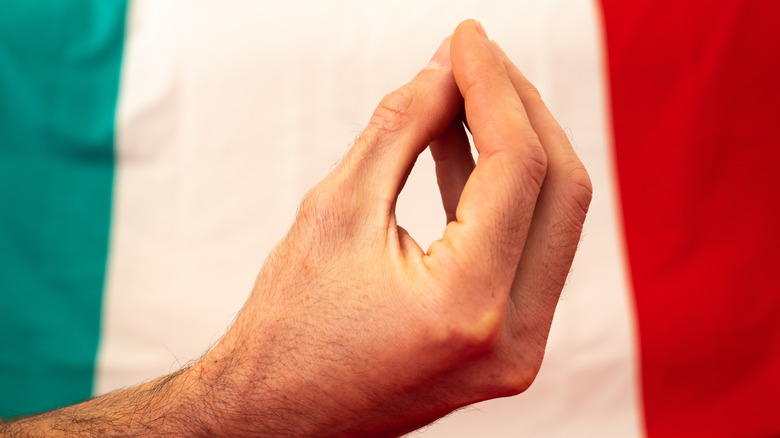Italian gestures: A language of its own
Italy has two languages: Italian and Italian hand gestures. If you want to fare well, you better know both. Italian hand gestures are an integral part of the country’s communication style, often used to express emotions, opinions, and intentions in a way that words alone simply cannot. There are over 250 Italian-specific hand gestures! Entire books are even written on the subject.
The “hand purse” is iconic — fingers and thumb come together, pointing upward in a bunch. There’s even an emoji of it. Rick Steves explains that this gesture is used to question what is happening or to show perplexity or disbelief, like saying, “What are you saying/doing?”. Depending on the context, it could also be used to call someone a fool. The “chin flick” with the fingers, from the neck up and out, tells someone you are not interested or bored.
Something more positive is the “cheek screw,” when you make a fist, stick out the index finger, and make a rotating motion toward your cheek to indicate that something is cute or delicious. Of course, the most Italian gesture of all is the “fingertip kiss” — the best way to show appreciation. Bring your fingers together, give them a symbolic kiss, and toss them in the air. Countries like France, Spain, Greece, and Germany have also adopted this gesture. “Italians are animated and dramatic, communicating as much with their bodies as with their mouths,” explains Steves (via HeraldNet). So, when in Rome…
When yes means no in the Balkans

As you travel around Europe, you may feel like certain countries are playing “opposite day.” But the truth is, no, they are not — and we here at Explore are not playing either! Rick Steves explains that certain cultures gesticulate “yes” and “no” in completely opposite ways. For example, Rick Steves mentions that in Bulgaria, “yes” is indicated by shaking your head, as if you were saying “no” in America. While “no” is an up-and-down head nod. Completely flipped.
Rick Steves warns that a similar reversal can be faced in Turkey. For affirmation, Turks use a similar up-and-down nod, like the U.S. However, to indicate “no,” Turks perform a backward tilt of the head, often accompanied by raised eyebrows. This has been known to cause some confusion, both for people traveling to these countries and, surely, for these locals traveling anywhere else in the world.
One theory to explain this difference suggests that during Ottoman rule, these Balkan countries reversed their “yes” and “no” gestures as a covert resistance to the forced conversion from Christianity to Islam. Basically, nodding to outwardly agree while internally denying. Another hypothesis proposes that these confusing head gestures have been influenced by Indian head shaking, transmitted from the East through wars and invasions over centuries. This reversed gesture is sometimes also seen in other Balkan areas, like Albania and Greece.
Offensive gestures: A travel essential

Pyrosky/Getty Images
When one learns a new culture, learning body-language pleasantries to indicate things like “please” and “thank you” is a usual starting point. However, it’s just as important to know the insults to avoid an awkward situation. Let’s begin with the “forearm jerk,” common in Southern Europe, and, as Rick Steves explains, a “jumbo version of flipping the bird.” In this gesture, you make a fist with your right hand, jerk your forearm up, and slap the right bicep with your left palm.
Rick Steves also cautions against throwing up the “V for victory” or “peace” sign with the palm facing toward you in the U.K. or other Commonwealth countries. Known as “the forks,” this gesture, equivalent to the American middle finger, is offensive and may put you in a very unpeaceful situation. If you’re asking for a table for two at a restaurant or ordering two pints of Guinness, just ensure your palm is facing the right way.
“The moutza” gesture involves an open palm extended toward someone, resembling a “talk to the hand” sign — this is relevant for Greece. The gesture has roots in the Byzantine Empire, where it was used to smear ash on criminals’ faces, with “moutzos” being the Ancient Greek word for ashes. Its meaning is the equivalent of the reverse peace sign and the forearm jerk — you get the idea. And remember that the lovely middle finger is just as offensive in Europe as anywhere else.
European gestures of superstition

Filippobacci/Getty Images
Hopefully, you won’t be in a situation where you have to use any of these more foul and superstitious gestures — and hopefully, no one will do them to you. Nonetheless, you should be aware. Rick Steves mentions an important gesture — the “eyelid pull.” This tricky one involves pulling down one’s lower eyelid with the finger, usually indicating skepticism, disbelief, or alertness to a situation. In France and Greece, it is made towards someone to indicate that they are watching you skeptically.
In Italy or Spain, however, the “eyelid pull” can be used as a friendly warning, as Rick Steves explains. Let’s say you’re at a market discussing a price, and a kind local makes this gesture while pointing at the shady merchant. They’re essentially giving you a friendly warning to watch out for the merchant’s trickery — perhaps they are trying to rip you off or sell you a faulty product.
The “rock’n’roll sign,” or as it is known in Italian, “le corna,” or simply “the horns,” is a hand gesture where the index and little fingers are extended while the middle and ring fingers are held down by the thumb. In Italy and other Mediterranean destinations, it is often used as a superstitious gesture to ward off bad luck, negative vibes, or the evil eye, “malocchio”. However, it can also have a more offensive meaning, implying that a man’s wife is being unfaithful. Rock on, but clearly, context is important.
Money matters and keeping count

George Rudy/Shutterstock
Local markets, sprawling malls, family-run shops — wherever you shop on your travels, one thing is for certain: Money matters. Rick Steves details a European hand-shaking gesture that can signify that something is considered expensive or overpriced. This gesture involves extending one hand out and shaking it back and forth in a small, quick motion. It’s a non-verbal way of communicating that the cost of an item or service is higher than expected. If you’re bargaining, this one is essential.
Moreover, in many parts of Europe, counting on fingers typically starts with the thumb, representing the number one, followed by the index finger for two, and so on. This method contrasts with the common practice in other regions, like the United States, where counting often starts with the index finger. So be careful, warns Rick Steves, if you start counting with your index finger, you might get two of something instead of one.
Communication is a delicate art. Between language barriers, social cues, mispronunciation, and jet lag, things abroad can get lost in translation. Thankfully, body language is an easy way to communicate. “To really immerse yourself in the culture, it’s important to take risks and communicate,” advises Rick Steves (via SFGATE). You might not need to learn all 850+ gestures; but hopefully, by knowing these few essential ones, your next trip to Europe will be a little more gesticular — in a good way.

